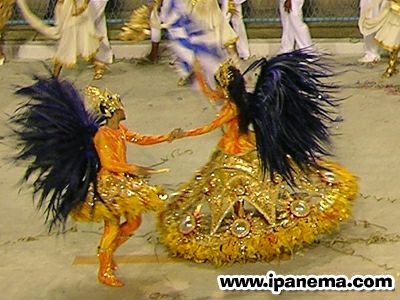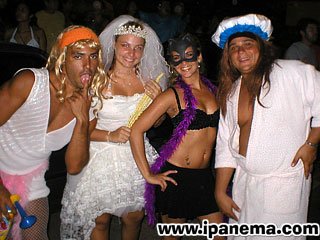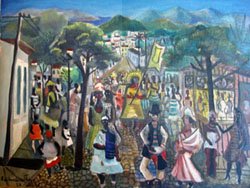Colonial Rio - how everything began
The first records of Carnival festivities in Rio de Janeiro date back to 1723. Immigrants from the Portuguese islands of Açores, Madeira and Cabo Verde introduced here the Entrudo.
The idea was basically getting everybody soaked wet. People would go out in the streets with buckets of water and limes, and everybody could be a potential victim. Even Emperors took part in the fun. There's a curious record of a woman being arrested in 1855 for throwing a lime at Dom Pedro I's escorts. Authorities frowned upon the lack of restraints of Entrudo fun, and eventually it was outlawed.
Zé Pereira was a contribution of a Portuguese shoemaker named José Nogueira de Azevedo, in the mid XIX century. On Carnival Mondays he would march in the streets with his friends playing drums, tambourines, pans, and whistles. Everybody was welcome to join the fun.
Grandes Sociedades or Great Societies was a more organized parade that debuted in 1855, with the presence of the Emperor himself. A group of eighty aristocrats in masks paraded with luxury costumes, music, and flowers. It was a big success. Democráticos, Fenianos and Tenentes do Diabo were the three most well-known groups.
Cordão Carnavalesco is a concept that got its start in 1870. There were characters like queens, kings, witches, peasants and dancers, and they performed according to the costumes they were wearing. There were also the Cordões de Velhos, where participants would wear huge papier-mâché masks and walk in an old man's gait.
Carnival in the early XX Century
 Ranchos Carnavalescos are a contribution of an immigrant from Bahia named Hilário Jovino da Silva. They started in 1872 as working class festivity. People would dress up in costumes and perform on the parade accompanied by an orchestra of strings, ganzás, flutes, and other instruments. They were more organized than the Cordões, and gained popularity around 1911.
Ranchos Carnavalescos are a contribution of an immigrant from Bahia named Hilário Jovino da Silva. They started in 1872 as working class festivity. People would dress up in costumes and perform on the parade accompanied by an orchestra of strings, ganzás, flutes, and other instruments. They were more organized than the Cordões, and gained popularity around 1911.
With the sponsorship of brewery Hanseática, the Ranchos started organized competitions. They became one of the main attractions of Rio de Janeiro's Carnival, together with the Great Societies. The parade already included a first-wing (abre alas), an orchestra, a male and female choir, and a couple of mestre sala and porta bandeira.
The parades were halted during World War II and started again in 1947. By then the competition happened on Av. Rio Branco. The last competition of ranchos was in 1990, and the winner was a club named Decididos de Quintino.
Corso was a novely intruduced in 1907 with a parade of cars along Av. Rio Branco (then named Av. Central). They were the granddaddys of today's sophisticated floats. Revelers brought along streamers and paper confetti, plus lança-perfume, a spray of cologne water that would give you a sort of a buzz. In the 30's this celebration became so popular that almost all car-owners in the city participated! The parade started on Sunday in Botafogo and went all the way to Av. Central.
Rio, Birthplace of Samba
It all started in the end of the XIX Century in what was then known as Little Africa (Pequena Africa), the residence of the tias baianas. These were ladies who came from Bahia, and made a living selling food delicacies around town in their typical white dresses with big round skirts. They were also the priestesses of Candomble, and had a great influence in the community.
Tia Ciata may have been the most famous of these tias. Born Hilaria Batista de Almeida in the region of Bahia known as Reconcavo Baiano around 1854, she first lived near Campo de Santana. But the address that entered in history was Rua Visconde de Itaúna, 177. In her living room meetings were often entertained with live music played by talents like Pixinguinha and Donga (son of Tia Amelia). In the back lot of her house happened the samba, a term then used to denominate the ritual Candomble dance to drums and handclaps.
Eventually the two beats got together, and Pelo Telefone, the first song labeled as a samba, was composed in her house. Another song that made samba history is Noel Rosa's Com que Roupa?, that had a broader range of instruments that became staples in a samba song.
Blocos de Sujos, Blocos de Baianas
 The cordões evolved into blocos de sujos, where everyone could join in plain clothes, and blocos de baianas. The curious detail was that these baianas were actually men dressed in white colonial clothes, and acted as security to the blocos. There was a percussion band and vocalist, with a women-only chorus of pastoras.
The cordões evolved into blocos de sujos, where everyone could join in plain clothes, and blocos de baianas. The curious detail was that these baianas were actually men dressed in white colonial clothes, and acted as security to the blocos. There was a percussion band and vocalist, with a women-only chorus of pastoras.
The peak of these blocos was in the 30's and 40's. Cacique de Ramos and Bafo da Onça are two of the most well-known. Today you can watch the blocos parade on Av. Rio Branco all Carnival days. The parades start at 2 p.m. from Carnival Saturday to Tuesday, and access is free.
Contemporary versions of blocos such as the Monobloco and bandas like Banda de Ipanema operate a little differently. You will find more details at All About Street Carnival.
The Birth of the Samba School
In the end of the 20's some organizers of blocos felt the need to evolve, and found inspiration in the ranchos that were somewhat more organized. The term escola de samba (samba school) is credited to Ismael Silva, from Estácio. The samba gained more fluidity to be adapted to the evolution of the samba school. Mangueira, founded in 1928 is the first samba school. The nickname Estacao Primeira is because it is right at the first stop after train station Central do Brasil.
In the 40's and 50's the samba schools consolidate their evolution cycle, with a theme, a theme song, costumes and floats. In 1959 Nelson de Andrade, then president of Salgueiro, invited artists Dirceu and Maria Louise Nery to design their parade featuring painter Debret as the theme. This initiative brought a whole new concept of design that would result in today's carnavalescos.
In the 60's and 70's the samba started to gain prestige with the middle class and upper middle class. Albino Pinheiro, the founder of Banda de Ipanema, helped this integration process with his famous pre-Carnival balls. The Samba Parade started to become more popular, and in 1971 for the first time there was a time limit set to the parade of each samba school. The songs gain a faster beat, and in 1972 the first album with the theme song of samba schools was released.




No comments:
Post a Comment